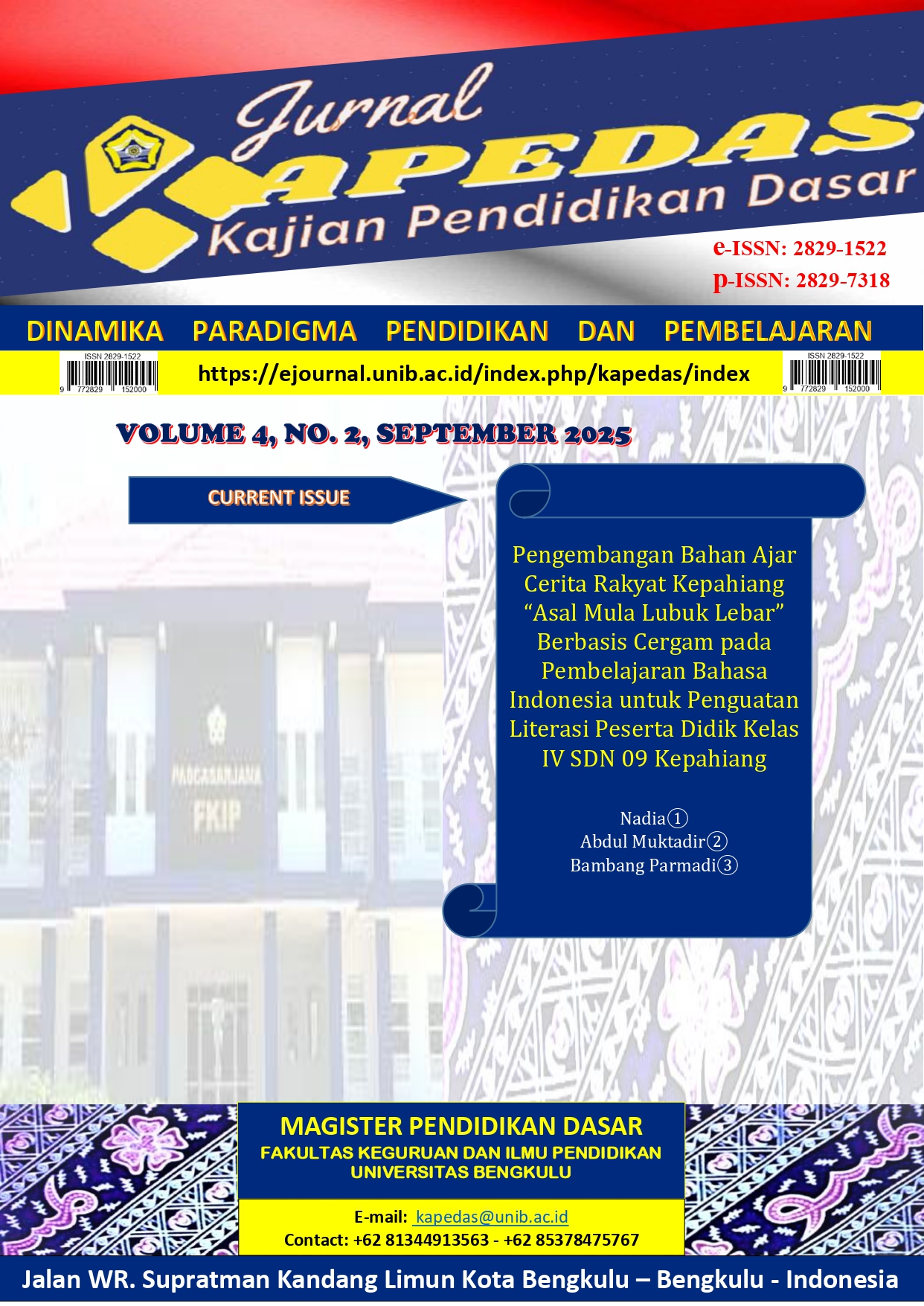Main Article Content
Abstract
The purpose of this study was to analyze the effect of Science Learning using the Quantum Learning (QL) learning model assisted by Smart Book media on students' creative thinking abilities. The type of data used is quantitative data using instruments in the form of interviews, documentation, question instruments, and expert validation sheets. Based on the results of the study, it was found that the use of Smart Book media in science learning had a significant effect on the dimensions of fluent thinking ability. This is indicated by the average posttest of fluent thinking ability in the control class of 71. Meanwhile, the average posttest result of the experimental class was 88. The use of Smart Book media in science learning has a significant effect on the dimension of flexible thinking ability. This is indicated by the average posttest of flexible thinking ability in the control class of 69. Meanwhile, the average posttest result of the experimental class was 90. The use of Smart Book media in science learning has a significant effect on the dimension of Original thinking ability. This is indicated by the average posttest of Original thinking ability in the control class of 67. Meanwhile, the average posttest result of the experimental class was 87. Furthermore, there is no relationship between the dimensions of fluent, flexible and Original thinking ability with the use of Smart Book media in science learning.
Article Details
Copyright (c) 2025 Lita Harmika, Endang Widi Winarni, Abdul Muktadir

This work is licensed under a Creative Commons Attribution-ShareAlike 4.0 International License.

Karya ini dilisensikan di bawah Creative Commons Attribution-ShareAlike 4.0 International License .
References
- Ahmadi, H. A., & Uhbiyati, N. (1991). Ilmu Pendidikan (Cetakan Pertama). Jakarta: PT. Rineka Cipta.
- Ahmadi, H. A., & Uhbiyati, N. (2017). Ilmu Pendidikan (Cetakan Kedua). Jakarta: PT. Rineka Cipta.
- Barnawi & M. Arifin. (2015). Strategi & Kebijakan Pembelajaran Pendidikan Karakter. Jogjakarta: Ar-Ruzz Media.
- Brookfield. (1987). Developing Critical Thinkers. San Fransisco: Jossey Bass Publiser.
- Rahayu, S., & Koto, I. (2023). Pengaruh Model Problem Based Learning (PBL) terhadap Kemampuan Berpikir Kreatif Siswa Kelas IV pada Materi Gaya dan Gerak. Jurnal Pembelajaran dan Pengajaran Pendidikan Dasar, 6(2), 258-267.
- Wahab, A., Junaedi, J., & Azhar, M. (2021). Efektivitas Pembelajaran Statistika Pendidikan Menggunakan Uji Peningkatan NGain di PGMI. Jurnal Basicedu, 5(2), 1039–1045.Atmawarni. (2011). Penggunaan Multimedia Interaktif Guna Menciptakan Pelajaran yang Inovatif di Sekolah Dasar. Vol. 4 No.1 diakes pada April 2011 dari https://ojs.uma.ac.id/index.php/perspektif/article/download/78/36/162.
- Waruwu, Yaedi. (2023). Pembelajaran Membaca Quantum Learning. PT. Sonpedia Publishing Indonesia.
References
Ahmadi, H. A., & Uhbiyati, N. (1991). Ilmu Pendidikan (Cetakan Pertama). Jakarta: PT. Rineka Cipta.
Ahmadi, H. A., & Uhbiyati, N. (2017). Ilmu Pendidikan (Cetakan Kedua). Jakarta: PT. Rineka Cipta.
Barnawi & M. Arifin. (2015). Strategi & Kebijakan Pembelajaran Pendidikan Karakter. Jogjakarta: Ar-Ruzz Media.
Brookfield. (1987). Developing Critical Thinkers. San Fransisco: Jossey Bass Publiser.
Rahayu, S., & Koto, I. (2023). Pengaruh Model Problem Based Learning (PBL) terhadap Kemampuan Berpikir Kreatif Siswa Kelas IV pada Materi Gaya dan Gerak. Jurnal Pembelajaran dan Pengajaran Pendidikan Dasar, 6(2), 258-267.
Wahab, A., Junaedi, J., & Azhar, M. (2021). Efektivitas Pembelajaran Statistika Pendidikan Menggunakan Uji Peningkatan NGain di PGMI. Jurnal Basicedu, 5(2), 1039–1045.Atmawarni. (2011). Penggunaan Multimedia Interaktif Guna Menciptakan Pelajaran yang Inovatif di Sekolah Dasar. Vol. 4 No.1 diakes pada April 2011 dari https://ojs.uma.ac.id/index.php/perspektif/article/download/78/36/162.
Waruwu, Yaedi. (2023). Pembelajaran Membaca Quantum Learning. PT. Sonpedia Publishing Indonesia.
